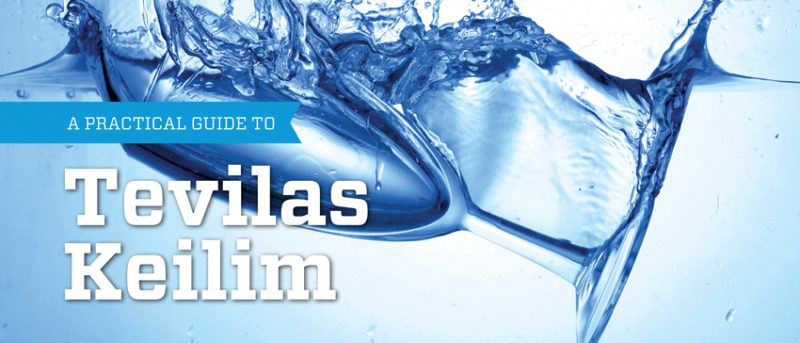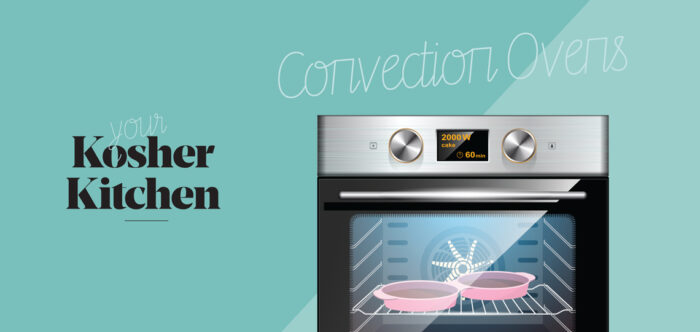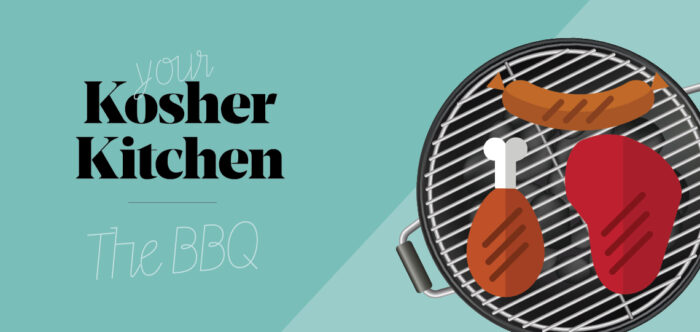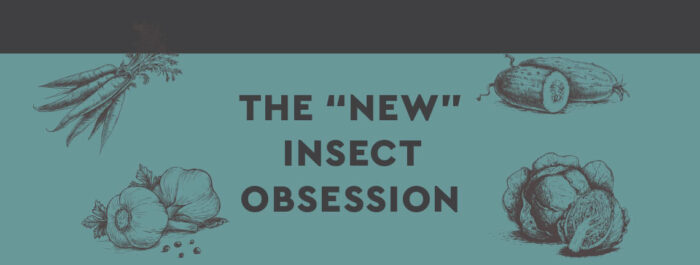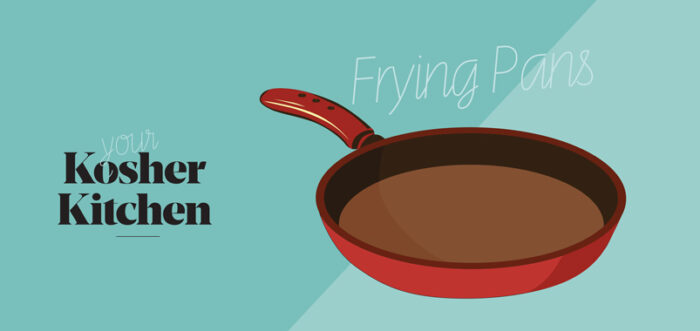Introduction
The Torah discusses the laws of tevilas keilim in Bamidbar.1 After the Jewish people returned from a battle with the Midyanites, they came back with many possessions that they took from the enemy, including equipment. Hashem tells Elazar, the son of Aharon the Kohen Gadol, that in addition to purifying and kosherizing the equipment, the Jewish people must immerse the metal equipment in the mikvah.
“The gold, the silver, the copper, the iron, the tin and the lead, whatever is used in fire, must be passed through fire by you, and then it will be purified. They must, however, [also] be cleansed with sprinkling water [alternatively, with mikvah water]. Whatever (utensils) are not used in fire [but rather, with cold foods], should be passed through [mikvah] water by you [right away, since they do not need to be purged].” The Torah includes equipment that were used “with fire” (for hot food) and equipment used “without fire” (for cold food), as well as new equipment – they all require tevilas keilim. 2
From these pesukim our Chachomim extracted the following guidelines about tevilas keilim:
1. The equipment must be entirely clean before it is immersed into the mikvah waters, otherwise they will remain impure.3
2. Only equipment used for a meal requires tevila. This is similar to koshering, which is only done for equipment used with food.4
3. The only materials that require tevila are those that are made of metal. However, wood, earthenware and stone do not require tevila. The Talmud states that glass also requires tevilas keilim, since it is similar to metal since both can be repaired with the heat of a fire (wood, earthenware and stone cannot).5
4. If the equipment was purchased or gifted from a non-Jew, it requires tevila. If it was just borrowed or leased from a non-Jew, or if one purchased metal and manufactured a utensil himself, it would not require tevila.6
From the source quoted earlier, it appears that tevilas keilim is a mitzvah d’oraisa (Biblical), which is the opinion of many Rishonim. Other Rishonim disagree and are of the opinion that this mitzvah is d’rabbonon (Rabbinical) and the reason for the mitzvah is to add a level of kedusha to our equipment by immersing them into a mikvah.7 Some Poskim resolve this disagreement between the above Rishonim by explaining that the mitzvah of toiveling keilim is d’oraisa (Biblical), however the prohibition of not using them before immersion is d’rabbonon (Rabbinical).8 Other Poskim disagree and hold that the entire mitzvah is d’oraisa.
One may not use a vessel, even once, prior to tevila. If one accidently used equipment which was not yet immersed in a mikvah, the food may be eaten.9 However, one should remove the food from the vessel as soon as he realizes it was not immersed in a mikvah.
Some Rishonim say that tevilas keilim is a Biblical decree that does not have a revealed reason (a gezeiras hakasuv). The Yerushalmi states: “[Tevilas keilim] is [required] to remove the impurities of the Aku”m and to bring the item into the holiness of the Jewish people.”10
Materials:
Metal All metals require tevilas keilim with a brocha, including gold, silver, copper, iron, tin and lead.
Aluminum Requires tevila with a brocha.11
Glass (including Pyrex, Duralex, Corelle, crystal and fiberglass) — Requires tevila with a brocha.12
Plastic, nylon, Formica, melamine and rubber The custom is not to require tevila, however, one may be more stringent and toivel without a brocha.13
Leather Does not require tevila.
Wood Does not require tevila.
Stone, bone, horn & marble Does not require tevila.
Earthenware, bone china Does not require tevila.
Porcelain Some require tevila without a brocha, some do not.14
Combinations Any piece of equipment that includes parts of metal or glass (if the metal or glass are essential to the use of this equipment and they come in contact with the food) do require tevila with a brocha. Otherwise, they do not require tevila.15
Glazed utensils If the vessel is coated with metal or glass, even if only coated on the inside, one should toivel without a brocha. If it is only coated on the outside, no tevila is required.16 If a metal or glass utensil is coated with earthenware, Teflon or enamel, one should toivel without a brocha.17 Metal or glass equipment that was painted still requires tevila with a brocha since paint does not change the status of the equipment.18
Usage:
Only equipment used for a meal or meal preparation requires tevila with a brocha. These include dishes, cutlery and serving utensils and pots, pans and ladles.
Utensils which were not manufactured with the intention to use for a meal, such as a razor knife or scissors, can be used temporarily for foodstuff without tevila. Similarly a netilas yadayim cup and a drying rack can be used occasionally with food without tevila, since it was not created for food use.
Even if the utensil was manufactured for food, if one were to use it only for non-food use, such as a knife being used as a box cutter, it would not require tevila. However, if one were to use the knife sometimes to cut food as well, it would require tevila without a brocha.19
Tevila is not required for utensils that aid in food processing, yet do not produce a final product, such as rolling pins, cookie cutters, coffee grinder, and sifters. Some have the custom to toivel them without a brocha. If the utensil may be used occasionally with finished goods, such as a grinder or scraper, one should toivel without a brocha. However, a utensil which is normally used for final processing, such as pots, pans, metal grater and glass cutting boards requires tevila with a brocha, even if one only plans to use it during the early stages of food production.20
Only utensils that come in direct contact with food require tevila. This includes barbeque grills, griddles, pot lids, peelers, and the racks and trays of a toaster oven. However, if the utensils are not used directly on the food, such as hoods of barbeque grill, blech, burners, toaster oven, baking lids and milk pitchers, tevila is not required. Some include an egg pot as well.21 According to many Poskim, can openers and corkscrews do not require tevila. Although it sometimes comes in contact with the food, it is not intentional. According to some Poskim, nut crackers should be toiveled without a brocha, while some require toiveling with a brocha.22 Sheet pans and baking pans require tevila, although they are only used with a liner or foil.
Equipment which is used to store food, such as cans, containers, thermos, and glass bottles require tevila without a brocha. If it occasionally is used for serving as well, like a pitcher, one should say a brocha.23
Disposable aluminum pans do not require tevila since they are not considered keilim. Even if one were to use it a few times, it is still not a permanent keili since it was designed for one-time use and is not durable. Some are more stringent and toivel the pans if they will be used more than once, especially if the aluminum is made of thicker, less flimsy material.24
Large equipment maybe harder to toivel, but is not exempt from tevila altogether. There are instances in halacha when some large equipment could be sold to a non-Jew who would then allow the Jew to borrow it for use. Usually, this is considered a loophole, but in some instances, such as a very large utensil, it may be allowed.25 An oven built into the ground is not a keili, so no tevila is necessary. Similarly large equipment which is not moveable, such as large ovens and fryers, do not required tevila. The same applies to utensils dedicated for this equipment.
Electrical equipment that comes into direct contact with food requires tevila – for example, if one has an electric water urn, electric hot plate or popcorn maker, one needs to toivel at least the parts (if they come apart) of the equipment that touches the food. The wire does not need to be toiveled. (Some poskim hold that the wire should be toiveled.) It is preferable to wait a few days until the appliance is completely dry after it was toiveled before using. If one is concerned that it may get ruined, one should discuss this matter with a rov.26 Some say that a toaster oven does not require tevila since it is used for bread which is edible before entering the toaster, but most Poskim disagree.27
Equipment that can be disassembled does not need to be taken apart before tevila. It can be toiveled either whole or apart, but a closed Thermos (or other item with a lid) needs to be opened before tevila.
Ownership:
The mitzvah of tevilas keilim applies to the equipment that was previously owned by a non-Jew, or even by a partnership between a Jew and a non-Jew. Even if a Jew built the equipment, tevila is required if it belonged to a non-Jew.28 Yet when one sells chometz to a non-Jew before Pesach through his rav, one is not required to toivel the vessels after Pesach.
In the Diaspora, most manufacturing companies are owned by non-Jews, or have a non-Jew as a partner. Therefore, if one is unsure about the ownership of a company, it must be assumed to be owned by a non-Jew and tevila with a brocha is required. In Israel, it is assumed that the owner of the manufacturing company is Jewish, and no tevila is required unless one finds out that the company is owned by a non-Jew.29 Some Poskim are of the opinion that in the USA one should not recite a brocha on tevilas keilim unless one knows definitively that the item belonged to a non-Jew. Most poskim disagree, and hold that one should make a brocha unless he knows that it was never owned by a non-Jew. When purchasing a vessel one should try to find out if it ever belonged to a non-Jew.
If one sends equipment to a non-Jewish handyman to repair, it does not require tevila once the equipment is returned,30 unless the metal used for repair belonged to the non-Jew and the equipment could not function without the repair. Therefore, if one were to send a knife to a non-Jewish sharpener, the newly sharpened knife would not require tevila. The same would apply if one sent sheet pans to be reglazed.
Industrial:
When dealing with industrial facilities and the industrial size equipment, there are a number of factors to consider when a Rov Hamachshir determines if tevilas keilim is required:
How large are the keilim?
What materials are they made from?
Are they electrical?
Are they stationary or connected to the ground?
Do they come into contact with the food directly?
At which stage in the production process do they come into contact with the food?
There is an additional factor to consider: are these utensils solely used for business purposes and not for personal use? Some Poskim are of the opinion that the food produced in industrial manufacturing plants is not for personal use, only for business purposes, so the equipment used are not called “Keili Seudah” and does not require tevila.
There is much debate about when this can be applied.31 A relevant practical application of this question is as follows: If one were to purchase a candy dish made from metal or glass from a store with a hashgocha, one should find out if the hashgocha required the store to toivel the dishes before selling them and if the store owner actually toivels them.
If not, one can still purchase the candy dish and use it until the candy is finished. At that point, one is required to toivel the dish before it is reused.
Unfortunately this article cannot cover all the intricate details related to the halachos of Tevilas Keilim. There are often differences of opinions in some scenarios. When in doubt one should consult with a rabbinic authority.
1. מטות פל”א פסוק כא-כג. ועיין ברש”י שם, רמב”ן שם, ובמפרשי רש”י (רא”ם וגו”א).
2. רש”י לומד כלים שתשמישם בצונן או חדשים מהפסוק “תעבירו במים”, והרמב”ן לומד מאותו פסוק של כלים שתשמישם בחמין “וטהר”.
3. רש”י לומד מהפסוק “אך את הזהב” למיעוטי חלודה ודבר החוצץ, והרמב”ן לומד מהפסוק “תעבירו במים” שצריך לנקות קודם.
4. גמ’ ע”ז דף ע”ה: ורש”י שם, ועיין ברשב”א תו”ה ב”ד ש”ד “איזהו דבר שבא באש וצריך להכשירו באש הוי אומר זה כלי סעודה”. אולם אי”ז כדי הכשרה מאיסור דמאיסור אין צריך להכשיר רק כלי שתשמישו בחמין, וכאן צריך להטביל ג”כ כלי חדש שלא השתמש מעולם.
5 .מהפסוק “אך את הזהב”. וזה כולל ו’ סוגי מתכות-הזהב,הכסף,הנחשת,הברזל, הבדיל והעופרת. ויש מסתפקים אם אלומיניום בכלל ג”כ. אולם זכוכית הוה מדרבנן. דהגמ’ ע”ז שם מביא –”הני כלי זכוכית הואיל וכי נשתברו יש להן תקנה ככלי מתכות דמו”.
6. גמ’ שם “לא שנו אלא בלקוחין וכמעשה שהי’ה אבל שאולין לא”
7. השיטות שזהו מה”ת –רש”י עה”ת, הרשב”א, והרי”ף. הרמב”ן עה”ת מסתפקא ליה,הרשב”א מבאר כן שיטת הרמב”ם (הל’ מאכ”א פי”ז ה”ה-ז) וכן כתבו הכ”מ והב”ח, אולם מפשטות ל’ הרמב”ם שם משמע שהוא מדרבנן. וכ”כ הפר”ת והכנה”ג בפירוש דברי הרמב”ם. וראה בשד”ח כללים מערכת טי”ת כלל ב’ הדיעות בזה. ובשו”ע אדה”ז או”ח סי’ קנ”ט סכ”א וסי’ שכ”ג ס”ח דפסק שהוא מה”ת, וע”ע בלקו”ש חי”ח מטות ב’
8. ישועות יעקב יו”ד סי’ ק”כ סק”א, ובמנח”י ח”א סי’ מ”ד מביאו וכן הובא בביאור הלכה או”ח סי’ שכ”ג ד”ה מותר, שמבאר כן שיטת הב”י. אולם במנח”י שם מביא שזה אינו מוסכם בכל הפוסקים. וכן יש לדייק משו”ע אדה”ז או”ח סי’ שכ”ג ס”ח “ואין צריך לומר לדברי האומרים שטבילת כלים היא מן התורה, שזהו תיקון חשוב לדברי הכל”, ולכן אסור לטובלו בשבת מכיון שעל ידי טבילה עושהו לכלי הראוי לשימוש. אולם גם לשיטת אדה”ז מותר בדיעבד כשעבר והשתמש מכיון שבדיעבד יש לסמוך על המתירים שסוברים שדין טבילה מד”ס, כמ”ש שם סוס”ח.
9. ועיין באג”מ יו”ד ח”ב סי’ מא דאפי’ אם השתמש בהם במזיד אין המאכל נאסר, כיון אין שום דין בליעה בכלי שחסר טבילה. והא דצריך להוציא המאכל מיד, היינו כשהכניס בעצמו, אולם אם קנהו מהחנות בלא טבילה כשמכוסה באוכלין, אין צריך להוציא המאכל מיד. וע”ע בספר טבילת כלים פ”ד ס”ט וסי”ב ובהערות שם בשם רשז”א.
10. ירושלמי ע”ז שם, והרא”ש והרשב”א והרמב”ם כתבו שהוא גזה”כ. ובלקו”ש חי”ח מטות ב’ מבאר כ”ק אדמו”ר מליובאוויטש שכל כלי שהוא ברשות הנכרי אפי’ כלי חדש יש ביכולת לנכרי להשתמש לאיסור, והיכולת הזו עושהו ככלי עם בליעת איסור, והדרך היחיד לסלק האיסור הוא ע”י טבילה וע”ע שם איך שמבאר כמה סוגיות ע”פ יסוד זה.
11. י”א שמה”ת רק ו’ סוגי מתכות הנ”ל חייבים בטבילה, ואולומיניום חייב רק מדרבנן מאותו סיבה שזכוכית חייב שאפשר להתיכו. ועיין באג”מ יו”ד ח”ב סי’ קסד ובאו”ח סי’ נח. האג”מ והש”ה פוסקים שמברכים על הטבילה, אולם רשז”א פוסק לטובלו בלא ברכה. ויש מתירים בלא טבילה.
12. בכמה מקומות בש”ס מסתפקא לי’ה אי זכוכית כחרס (מחול) או כמתכת (שנעשה ע”י התכה). ובד”כ פוסקים לחומרא. כאן מחמיר להחשיבו כמתכת. ועי’ במאירי בע”ז שם ובשבת טו: ואו”ה הארוך כלל נח סי’ נח. אולם איסורו רק מדרבנן.
13. רוב הפוסקים סוברים דאי”צ טבילה, וכן פסק הגר”מ פיינשטיין במאסף לתורה והוראה חוברת א’ עמ’ 11, וציץ אליעזר ח”ז סי’ ל”ז, וב”מ ח”ב סי’ נ”ב. ויש שסוברים להטבילם בלא ברכה.וכן מביא המנח”י ח”ג סי’ ע”ו, וכן המלמד להועיל, וכן הורה רז”ש דווארקין ע”ה מד”א דק”ק קראון הייטס. ונתפשט המנהג שלא להטבילם.
14. פ”ת סק”ב מביא דאי”צ טבילה וכן פוסק היבי”א יו”ד ח”ב סי’ ח, והגר”מ פיינשטיין במאסף לתורה והוראה חוברת ב’ עמ’ 20, אולם הערוה”ש מביא שיש להחמיר משום שיש להם לפעמים גלוזירט מזכוכית דקה ולכן נהגו להטבילם, וכן במסגרת השלחן סי’ ל”ז סק”א.
15. שם סע’ ו’ ומטבילו כולו כאחת
16. בגמ’ ע”ז עה: בענין כלי קוניא (דהיינו חרס המצופה במתכת) ובשו”ע שם ס”א וברמ”א ובש”ך שם ובביאור הגר”א סק”ב, ובענין מצופה בגלויזרט כיון שמעורב בו חול ככלי זכוכית דמיא. ועי’ בדרכ”ת יו”ד שם סקי”ח וי”ט, וע”ע בספר טבל”כ פי”א סקל”ט-מ”א.
17. ובענין אנאמל עי’ בספר טבל”כ פי”א סק”ו שמביא כן בשם רשז”א שחושש שמא הציפוי בטל לכלי.
18. דחזותא בעלמא הוא, וכן מביא ספר טבל”כ פ”א סק”ט בשם רשז”א
19. בדרכ”ת שם סקמ”ה מביא מהפר”ח בענין כלי שאינו מיועד לצרכי סעודה. וע”ע באב”נ חי”ד סי’ קו. ובענין כלי הראוי לסעודה שהולכים בו אחר ההשתמשות, הפר”ח סובר שהולכים אחר רוב תשמישו ואפי’ אם תשתמש בסכין לפעמים לאוכלים אינו חייב בטבילה. אולם הפר”ת סקי”א חולק וסובר שאין הולכים אחר רוב תשמישו וכ”ה ברמ”א ס”ח, וע”פ הרמ”א יש לטובלו בברכה,אולם הזב”צ סע’ נ”ב והערוה”ש סי’ מ-מא הכריעו לטובלו עם כלי אחר החייב בברכה או לטובלו בלא ברכה. וכ”כ בספר טבל”כ פ”א ס”ב.
20. בשו”ע שם ס”ה לגבי סכין של שחיטה פסק הרמ”א “וטוב לטובלו בלא ברכה”, ולגבי ברזלים שמתקנים בהם את המצות פסק דאי”צ טבילה, והכריע הש”ך דשאני סכין שאפשר להשתמש בו דבר המוכן לסעודה. אולם בברזלים כאלו וגם במחטים שתופרים בהם את העופות אי”צ טבילה. ועפ”ז כתב בספר טהר”י יו”ד ח”ב דף קב שבימינו סכינים של שחיטה אי”צ טבילה כיון שמקפידים לא להשתמש בהם לדבר אחר. אולם הט”ז חולק וסובר שהרמ”א מחמיר גם בברזלים לטובלו בלא ברכה ע”פ האו”ה שם. ועפ”ז החמיר הפר”ח (והפר”ת) והבן איש חי והחת”ס סק”ה. וע”ע בספר טבל”כ פ”א ס”ג, ובפי”א סכ”ו, סס”ח, סע”ב, סצ”ג, סצ”ט, סקי”ח, סקנ”ז וסקפ”ז.
21. בשו”ע שם ס”ד ובנו”כ ועי’ בדרכ”ת סק”י וסקל”ח ובספר טבל”כ פ”א סק”ז מביא בשם רשז”א שכל שתשמישו תמיד בשקית כגון בכד חלב חשיב השקית הפסק, ולא מצטרך טבילה. אולם אם תשמישו ארעי כגון נייר אלומוניום או נייר שעוה שלפעמים נוזל ממנו לכלי אין הנייר חשוב הפסק וחייב טבילה. ובענין כלי לבישול ביצים עי’ בספר טבילת כלים פי”א סק”י בשם רשז”א שיש לטובלו בלא ברכה כיון שלפעמים מביאים ביצה שלימה עם קליפתה לסעודה.
22. בספר טבל”כ פי”א סקכ”ד וסקק”ה-ו מביא מרשז”א שתלוי אם מביאים כמו שהוא עם קליפתם לשלחן מטבילם בברכה, ואם לאו בלא ברכה.
23. בדרכ”ת סק”ו ובספר טבל”כ פ”א ס”ח ופי”א סט”ז וסקי”ג ע”פ רשז”א. אולם ר’ משה היינימאן מתיר זכוכית בלא טבילה. ובענין מגירות המקרר שהאוכל לפעמים נוגע בהם ומ”מ נהגו שלא להטבילם,עי’ הטבילת כלים פי”א סק”ח שביאר רשז”א שכמו שהמקרר עצמו אינו חשוב כלי, כך המגירות בטלים אליה.
24. בשו”ת מנח”י ח”ה סי’ לב אות א ובחלק”י ח”ג סי’ קטו מתיר כלי ששימושו בו חד פעמי. והגרמ”פ במאסף לתורה והוראה חוברת ב’ עמ’ 40 מתיר להשתמש בו כמה פעמים, שזה לא עושה את הכלי לכלי קבוע. ויש שרוצים להחמיר אם משתמש בו יותר מפעם אחת
25. וי”א דהוא הדין בכלי גדול ממ’ סאה דהיינו אמה על אמה ברום ג’ אמות גובה (ושיעור זה במידות שלנו שנוי במחלוקת בין הגר”ח נאה והחזו”א ואכ”מ), ועי’ בכ”ז בדרכ”ת שם סק”ה ובספר טבל”כ פ”א ס”י דהטוטו”ד תליתאי ח”ב סי’ כ”ב מתיר בכלי המחזיק מ’ סאה שאינו חשוב כלי, ורע”א בשם הכנה”ג ובבינ”א שער או”ה סי’ סו שחולק ע”ז. והבינ”א וכמה פוסקים מחפשים התירים ללמד זכות למה העולם לא נהגו לטבול כלים גדולים. בספר גידולי טהרה סי’ י”ז מביא להתיר כלי קבוע בקרקע. ועי’ בארוכה בספר טבל”כ פ”א סקט”ז. ובענין מדפי מקרר עי’ בטבל”כ פי”א ס”י, ובענין דוד מים חמים שם סל”ו, ובענין שלחן ממתכת שם סר”ב.
26. החלקת יעקב מקיל בחשמל, מכיון שא”א להשתמש בלי הכנסתו לשקע, הוה כמו מחובר לקרקע ולא חשוב כלי. ורוב הפוסקים לא סברי כמוהו. ועי’ בש”ה יו”ד סי’ נ”ז ובמנח”י ח”ב סע”ב ובאג”מ יו”ד ח”א סי’ נ”ז ועי’ בארוכה בספר טבל”כ פי”א סנ”א בכמה עצות איך לתקן כלי חשמלי לטבילה. ובענין חוט חשמלי האגר”מ יו”ד ח”א סי’ נ”ז מקיל לא לטובלו. והמנח”י שם מחמיר לטובלו ג”כ..
27. בקובץ מאסף לתוו”ה חוברת א’ עמ’ 11 דן הגרמ”פ בטבילת כלי כשהאוכל ראוי לאכילה בלא טבילה, ומסיק דחייב בכלי מתכות (כמו כלי אוצר), ובמקום חשש קילקול יש להתיר. ובשו”ת ב”מ ח”ד סי’ ק’ פסק דצריך טבילה.
28. שו”ע שם ס”א ולכן המוכר כליו לנכרי והקונה אותם בחזרה חייב טבילה, וא”כ קשה איך כלל ישראל מוכרים חמצם כל שנה לנכרי, ואח”כ קונהו חזרה אחר הפסח. והגם שאי”צ למכור הכלי עצמו רק צריך להשכיר מקומו, אולם בהרבה שטרי מכירה וכן הוא בשטר שתיקן אדה”ז בעל התניא שכלל “וכן כלים חמוצים שיש עליהם חמץ בעין”. וביאר בזה כ”ק אדמו”ר מליובאוויטש בלקוטי שיחות מטו”מ תשל”ו שאין חיוב טבילה באופן שאין שכיח שהנכרי ישתמש בכלים אלו מכיון שטבילה הוה משום טומאת עכו”ם אי”כ חיוב טבילה, וע”ש באריכות איך שביאר בזה כמה סוגיות.
29. דבחו”ל לא אמרינן ספק ברכות להקל אא”כ הוה ספק השקול ולא רוב, שאז הוה כודאי נכרים. ולא אמרינן כל קבוע כמחצה על מחצה בנידו”ד. ועי’ באג”מ יו”ד ח”ב סוסי”מ ובאו”ח ח”ג עמ’ שג לגבי כלי מתכות לברך ובפרט בכלי שמיובא מסין, יפן ואפי’ מיוראפ, אולם בכלי זכוכית מצדד להקל, ולכה”פ יטבלם בלא ברכה. וכ”כ בשו”ת יבי”א ח”י חיו”ד סי’ יב פסק לברך גם בזכוכית. ועי’ בזה בטבל”כ פ”ב סק”ו השיטות לברך ולא לברך. וע”ע בהערות וביאורים אהלי תורה קובץ 999 מהרב ל.י. רסקין בזה.
30. וי”ח דאומן קונה בשבח כלי
31. מיוסד ע”פ תשובת השבט סופר תשובה ס”ז.
OK Kosher Cerification Field Representative


 EN
EN  ZH
ZH  KR
KR  BR
BR  ES
ES  IN
IN  IL
IL 
